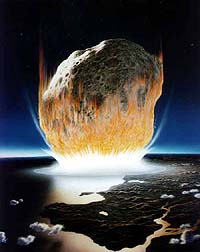| . |  |
. |
 Impact Events Shaped Rise Of Civilization
Impact Events Shaped Rise Of CivilizationLiverpool - March 7, 2000 - In a presentation to the Annual Meeting of the American Association for the Advancement of Science (AAAS), Dr Benny Peiser of Liverpool John Moores University, presented new evidence suggesting that more than 500 impact events of extraterrestrial orgin have punctuated Earth during the last 10,000 years. The great majority (70%) of these events have been of the Tunguska-type class of atmospheric impacts with an average energy yield of between 20 and 100 Mt TNT. However, more than 100 surface impacts, including more than a dozen oceanic impacts, are believed to have repeatedly devasted whole regions, small countries and early civilisations around the globe. In a worst case estimate, Dr Peiser said that up to eight climatic downturns detectable in the geological and climatological records of the Holocene may be directly associated with multiple impact events. "Episodes of increased cometary or meteoric activity punctuating societal evolution should be looked upon as potential agencies determining the rise and fall of ancient civilisations. Both the emergence and the collapse of human cultures, the Pleistocene-Holocene transition and the Neolithic Revolution, the onset and collapse of the Bronze Age civilisations, and even the collapse of the Roman Empire may be associated with episodes of increased cosmic activity and multiple impacts that may well have included incidents of cosmic dust loading." While most of these impacts occurred over unpopulated areas of the globe, there are historical accounts about devastating cosmic catastrophes. According to a number of Chinese records, about 10,000 people were killed in the city of Chi'ing-yang in 1490 AD due to the break-up of a small asteroid. About a dozen hypervelocity impact craters that date from the Holocene period (i.e. since the end of the ice age) have been discovered to date. The majority of impacts, however, that occurred during this crucial period of societal evolution have not been detected yet. According to Dr Peiser, "the 14 known Holocene impact craters most certainly paint a rather deceptive picture of our past. The fact that no massive impact crater dating to the Holocene has been detected, has led to the belief that no hemispheric or global impact disaster can possibly have happened. However, this is a widespread delusion." Yet there still is a regretable lack of interest by the scientific community to scrutinise the Holocene for major impact events. "The widespread ignorance of such cosmic disasters in historical time is due to the limited research focus on crater producing events. Yet only 3% of fatal impacts produce a hypervelocity surface crater on land", Dr Peiser points out. Tunguska-like impacts or "Super-Tunguskas" are thus taken out of the equation. Due to their catastrophic detonation above ground (or in the oceans), they often leave no obvious fingerprints behind. Dr Peiser also presented new impact simulations that estimate expected fatalities of cosmic impacts for the next 10,000 years. Without the establishment of effective strategies of planetary defense in the future, more than 13 million people are expected to die as a direct result of impact catastrophes in the next ten millennia. "We can, and indeed have to live with smaller, Tunguska-type impacts. There is little we can do about them. But we need to prevent the impact of larger objects which threaten the stability of our civilisation. "Unless we start planning ahead and develop the technology for the deflection of this threat, cosmic impacts will inevitably lead to major disasters in the future", Dr Peiser stressed. Based on computer simulations that take into account the current flux of near-Earth objects, a typical 10,000 years period with a constant human population of 5 billion can expect to experience: *110 fatal impacts resulting in a total of 13 million fatalities (an average of 120,000 fatalities per event).
In January, a UK Task Force was set up by Lord Sainsbury, the Science Minister, to look into the way in which Britain should respond to the impact hazard and how it can contribute to the international efforts prevent major impacts from happening in the future.
TERRADAILY.COM
|
| |||||||||
| The content herein, unless otherwise known to be public domain, are Copyright 1995-2016 - Space Media Network. All websites are published in Australia and are solely subject to Australian law and governed by Fair Use principals for news reporting and research purposes. AFP, UPI and IANS news wire stories are copyright Agence France-Presse, United Press International and Indo-Asia News Service. ESA news reports are copyright European Space Agency. All NASA sourced material is public domain. Additional copyrights may apply in whole or part to other bona fide parties. Advertising does not imply endorsement, agreement or approval of any opinions, statements or information provided by Space Media Network on any Web page published or hosted by Space Media Network. Privacy Statement All images and articles appearing on Space Media Network have been edited or digitally altered in some way. Any requests to remove copyright material will be acted upon in a timely and appropriate manner. Any attempt to extort money from Space Media Network will be ignored and reported to Australian Law Enforcement Agencies as a potential case of financial fraud involving the use of a telephonic carriage device or postal service. |